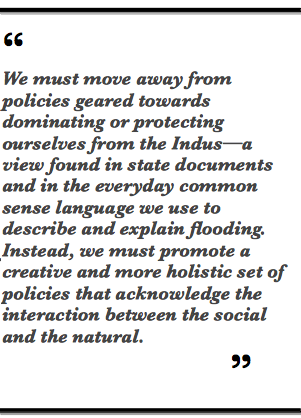English | اردو
Flooding is as social as it is natural. We must deal with it holistically.
On the surface, it seems that floods occur when nature acts outside the norm. The best response often seems to be an attempt to return to a pre-shock “normality” as quickly as possible. This is also the interpretation of floods taken by the Pakistani state. The focus of the latest flood planning document released by the National Disaster Management Authority (NDMA), the 2012 National Monsoon Contingency Plan, is on repairing flood control infrastructure and maintaining stocks of emergency relief supplies. The international donor community holds a similar response to floods: the goal is to funnel money to the right people at the right time to enable a speedy return to normalcy.
This approach seems reasonable. It is, however, based on the untenable assumption that nature acts on society from the outside, as an independent force disconnected from what is happening on the ground. But nature is not something you can consider as separate from society.

Take the interaction between canal operation and the Indus River’s silt. Silt is made up of particles of dirt and clay that the Indus chips off the Himalayas. An estimated 650 million tons of silt are carried into Pakistan by the Indus every year. If canals are stopped from periodically overflowing their banks and depositing silt in the floodplain—as they are because of state policies in the Indus basin—silt comes to rest at the bottom of canals. This slowly raises the elevation of canal-beds and decreases their capacity to hold water, making the system as a whole more vulnerable to large-scale flooding. Floods are not just a result of excessive rain, or nature acting on society from the outside. They are a result of social systems as well.
Silt also shapes economic relations. Canals clogged with silt make the delivery of canal water inefficient, especially for farms located at their tail-end. According to a study by Dr. Muhammad Latif of the University of Engineering and Technology (UET), the productivity of tail-end farms in Punjab is cut by up to half because of their physical location on the canal. Floods are not external to society–they are part of a complex set of relations formed around the Indus River.


